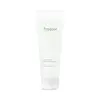What's inside
What's inside
 Key Ingredients
Key Ingredients

No key ingredients
 Benefits
Benefits

 Concerns
Concerns

 Ingredients Side-by-side
Ingredients Side-by-side

Water
Skin ConditioningGlycerin
HumectantSodium Cocoyl Isethionate
CleansingPotassium Cocoyl Glycinate
Lauryl Hydroxysultaine
CleansingSodium Chloride
MaskingCitric Acid
BufferingGlyceryl Oleate
EmollientC10-16 Alkyl Glucoside
EmulsifyingCaprylyl/Capryl Glucoside
CleansingStearic Acid
CleansingGlycol Distearate
EmollientHydroxypropyl Starch Phosphate
Salicylic Acid
MaskingSorbitan Olivate
EmulsifyingHouttuynia Cordata Extract
Skin Conditioning1,2-Hexanediol
Skin ConditioningSodium Benzoate
MaskingDisodium EDTA
Allantoin
Skin ConditioningHydroxyethylcellulose
Emulsion StabilisingEthylhexylglycerin
Skin ConditioningAloe Barbadensis Leaf Extract
EmollientOlea Europaea Fruit Oil
MaskingBrassica Oleracea Italica Extract
AstringentMedicago Sativa Extract
TonicBrassica Oleracea Capitata Leaf Extract
Skin ConditioningTriticum Vulgare Germ Extract
Skin ConditioningBrassica Campestris Extract
Skin ConditioningRaphanus Sativus Seed Extract
Skin ConditioningMelaleuca Alternifolia Leaf Extract
PerfumingCamellia Sinensis Leaf Extract
AntimicrobialGalactomyces Ferment Filtrate
HumectantCentella Asiatica Extract
CleansingCarica Papaya Fruit Extract
Skin ConditioningMelaleuca Alternifolia Leaf Oil
AntioxidantTocopheryl Acetate
AntioxidantSodium Hyaluronate
HumectantCaprylyl Glycol
EmollientPanthenol
Skin ConditioningGlycyrrhiza Uralensis Root Extract
Skin ConditioningDiospyros Kaki Leaf Extract
Skin ProtectingMorus Alba Bark Extract
Skin ConditioningOpuntia Coccinellifera Fruit Extract
Skin ConditioningButylene Glycol
HumectantMadecassoside
AntioxidantDextrin
AbsorbentAsiaticoside
AntioxidantWater, Glycerin, Sodium Cocoyl Isethionate, Potassium Cocoyl Glycinate, Lauryl Hydroxysultaine, Sodium Chloride, Citric Acid, Glyceryl Oleate, C10-16 Alkyl Glucoside, Caprylyl/Capryl Glucoside, Stearic Acid, Glycol Distearate, Hydroxypropyl Starch Phosphate, Salicylic Acid, Sorbitan Olivate, Houttuynia Cordata Extract, 1,2-Hexanediol, Sodium Benzoate, Disodium EDTA, Allantoin, Hydroxyethylcellulose, Ethylhexylglycerin, Aloe Barbadensis Leaf Extract, Olea Europaea Fruit Oil, Brassica Oleracea Italica Extract, Medicago Sativa Extract, Brassica Oleracea Capitata Leaf Extract, Triticum Vulgare Germ Extract, Brassica Campestris Extract, Raphanus Sativus Seed Extract, Melaleuca Alternifolia Leaf Extract, Camellia Sinensis Leaf Extract, Galactomyces Ferment Filtrate, Centella Asiatica Extract, Carica Papaya Fruit Extract, Melaleuca Alternifolia Leaf Oil, Tocopheryl Acetate, Sodium Hyaluronate, Caprylyl Glycol, Panthenol, Glycyrrhiza Uralensis Root Extract, Diospyros Kaki Leaf Extract, Morus Alba Bark Extract, Opuntia Coccinellifera Fruit Extract, Butylene Glycol, Madecassoside, Dextrin, Asiaticoside
 Reviews
Reviews

Ingredients Explained
These ingredients are found in both products.
Ingredients higher up in an ingredient list are typically present in a larger amount.
Citric Acid is an alpha hydroxy acid (AHA) naturally found in citrus fruits like oranges, lemons, and limes.
Like other AHAs, citric acid can exfoliate skin by breaking down the bonds that hold dead skin cells together. This helps reveal smoother and brighter skin underneath.
However, this exfoliating effect only happens at high concentrations (20%) which can be hard to find in cosmetic products.
Due to this, citric acid is usually included in small amounts as a pH adjuster. This helps keep products slightly more acidic and compatible with skin's natural pH.
In skincare formulas, citric acid can:
While it can provide some skin benefits, research shows lactic acid and glycolic acid are generally more effective and less irritating exfoliants.
Most citric acid used in skincare today is made by fermenting sugars (usually from molasses). This synthetic version is identical to the natural citrus form but easier to stabilize and use in formulations.
Read more about some other popular AHA's here:
Learn more about Citric AcidSalicylic Acid (also known as beta hydroxy acid or BHA) is a well-known ingredient for treating skin that struggles with acne and clogged pores. It exfoliates both the skin's surface and deep within the pores to help clear out buildup, control oil, and reduce inflammation.
Unlike AHAs (alpha hydroxy acids), salicylic acid is oil-soluble. This allows it to penetrate into pores which makes it especially effective for treating blackheads and preventing future breakouts.
Salicylic acid is also known for its soothing properties. It has a similar structure to aspirin and can calm inflamed or irritated skin, making it a good option for acne-prone skin that is also sensitive.
Concentrations of 0.5-2% are recognized by the U.S. FDA as an over-the-counter topical acne product.
It can cause irritation and/or dryness if one's skin already has a compromised moisture barrier, so it's best to focus on repairing that before introducing this ingredient into your routine.
While salicylic acid does not increase sun sensitivity, it’s still important to wear sunscreen daily to protect your skin.
If you are looking for the ingredient called BHA or Butylated Hydroxyanisole, click here.
Learn more about Salicylic AcidSodium Benzoate is a preservative. It's used in both cosmetic and food products to inhibit the growth of mold and bacteria. It is typically produced synthetically.
Both the US FDA and EU Health Committee have approved the use of sodium benzoate. In the US, levels of 0.1% (of the total product) are allowed.
Sodium benzoate works as a preservative by inhibiting the growth of bacteria inside of cells. It prevents the cell from fermenting a type of sugar using an enzyme called phosphofructokinase.
It is the salt of benzoic acid. Foods containing sodium benzoate include soda, salad dressings, condiments, fruit juices, wines, and snack foods.
Studies for using ascorbic acid and sodium benzoate in cosmetics are lacking, especially in skincare routines with multiple steps.
We always recommend speaking with a professional, such as a dermatologist, if you have any concerns.
Learn more about Sodium BenzoateChances are, you eat sodium chloride every day. Sodium Chloride is also known as table salt.
This ingredient has many purposes in skincare: thickener, emulsifier, and exfoliator.
You'll most likely find this ingredient in cleansers where it is used to create a gel-like texture. As an emulsifier, it also prevents ingredients from separating.
There is much debate on whether this ingredient is comedogenic. The short answer - comedogenic ratings don't tell the whole story. Learn more about comegodenic ratings here.
The concensus about this ingredient causing acne seems to be divided. Research is needed to understand if this ingredient does cause acne.
Scrubs may use salt as the primary exfoliating ingredient.
Learn more about Sodium Chloride